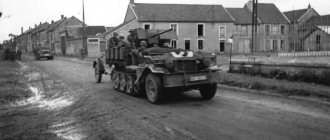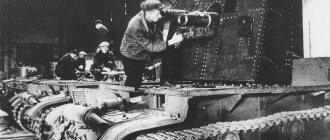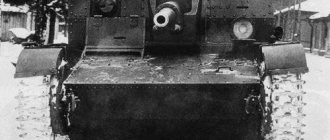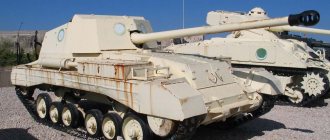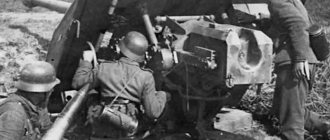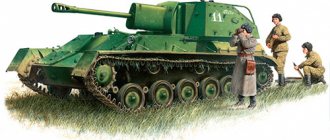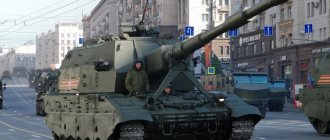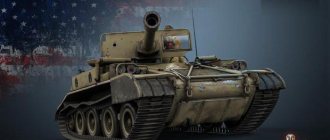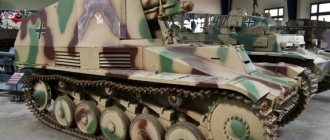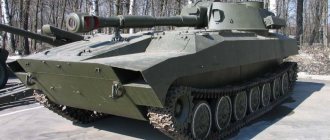Self-propelled gun "Panzerjager I"
47-mm anti-tank self-propelled gun “PANZERJAGER I”
One of the main disadvantages of the PzKpfw I tanks was their weak firepower. Such a serious drawback, combined with weak armor protection, led to the rapid obsolescence of vehicles of this class. However, German engineers very quickly found a use for the disused chassis. Self-propelled anti-tank guns certainly had to have higher mobility, since, in accordance with pre-war doctrine, their deployment and use were not much different from the tactics of using field artillery. The Germans were the first to see the depravity of this principle. Indeed, if the guns did not end up where the enemy tanks were supposed to appear, then they were of no use. And since there were always not enough anti-tank guns, the conclusion suggested itself: to be truly effective, a tank destroyer must move at the same speed as the attacking tank.
Similar thoughts led to the creation of a combat vehicle with an anti-tank gun based on a tank chassis. The first anti-tank self-propelled gun of this type was built by the Berlin company Alkett on the basis of the PzKpfw I Ausf light tank. B. Specialists from the Alkett company replaced the tank’s turret with a fixed, rather unsightly-shaped, fixed cabin that was open at the top and at the rear. The side walls of the cabin were installed at an angle, which was supposed to provide additional protection from armor-piercing shells, but the thickness of the frontal and side armor did not exceed 14.5 mm, and the side walls of the cabin did not even extend beyond the imaginary line that could be drawn perpendicular to the breech guns. Only the front of the cabin provided real protection. The gun crew was located at the rear of the vehicle, and felt as uncomfortable as behind the shield of a field gun. The weapon chosen was a Czech 47mm cannon with excellent ballistic characteristics with a 43-caliber barrel (initial projectile speed 775 m/s), a large number of which fell to the Germans after the capture of Czechoslovakia. The fixed cabin and high-mounted carriage significantly limited the horizontal sector of fire. It did not exceed 15 degrees to the left and right relative to the longitudinal axis of the machine. The gun elevation angle was +12 degrees, which, however, was not important for a tank destroyer. From a distance of 500 m, cannon shells easily pierced armor up to 70 mm thick. The ammunition included 86 rounds. The vehicle did not have auxiliary weapons in the form of a machine gun, and in close combat the crew defended themselves with the help of individual small arms. In addition to the driver, the crew included two more artillerymen - this crew was enough to service a small 47-mm gun. The Germans began to produce these guns on their own, but did not produce very many of them, since there was not enough chassis for conversion. The center of gravity of the vehicle was quite high, which made the self-propelled gun unstable when moving over very rough terrain. In addition, the silhouette of the car was so high that the camouflage net did not help to hide it.
The self-propelled gun was powered by a six-cylinder liquid-cooled Maybach NL 38TKRM engine with a power of 74 kW, which allowed the vehicle to move on paved roads at a maximum speed of 42 km/h. The chassis, for one side, included five rubberized road wheels, four rubberized support rollers, a front drive wheel and a rear idler wheel. Unlike the chassis of the light tank PzKpfw I Ausf. And, the guide wheel is raised from the ground. In 1940, self-propelled guns entered service with the Wehrmacht combat units that took part in the French campaign. Some of the vehicles arrived in North Africa, where they actively participated in combat operations before the advent of more advanced models of self-propelled guns, and on the Eastern Front. A total of 202 self-propelled guns were manufactured.
Tactical and technical characteristics of the 47-mm anti-tank self-propelled gun “Panzerjager 1”
Combat weight, t – 6.4 Crew, people. – 3 Overall dimensions, mm: length – 4420 width – 1850 height – 2250 ground clearance – 295 Reservations, mm: deckhouse – 14.5 Armament: 47 mm Pak 38 (t) gun Ammunition – 86 rounds Engine: “Maybach” HL38TKRM, 6-cylinder, carburetor. in-line, liquid cooling, 74 kW at 3000 rpm Maximum speed, km/h – 42 Cruising range on the highway, km – 140 Obstacles overcome: ascent, degrees. – 30 vertical wall, m – 0.37 ditch width, m – 1.40 ford depth, m – 0.60
Tank destroyer "Panzerjager-1"This photo of the Panzerjager-1 tank destroyer clearly shows the improvisational nature of this design, created using the chassis of an outdated T-1 light tank, which had a fairly powerful gun and weak crew protection.
In 1934, production of T-l tanks began, which were intended primarily for crew training. Due to the shortage of armored vehicles at the beginning of World War II, they began to be used as combat vehicles. The T-l crew consisted of two people, it was armed with two machine guns and had weak armor protection. Most of these tanks were withdrawn from combat service in 1941 and transferred to training rank. In addition, a certain number of spare chassis remained, on the basis of which it was decided to create the first German self-propelled anti-tank artillery mounts. By that time, there was a need to have such installations in anti-tank units instead of conventional towed guns. The first example of an anti-tank self-propelled gun was the 37-mm Pak 35/36 gun, mounted on the chassis of the T-l tank. The concept of the installation was promising, but by 1940 it became clear that the 37 mm caliber would not be able to fight modern tanks, and the Panzerjager I fur 4.7-cm Pak(t) installation with a 47-mm Czech anti-tank gun, which could penetrate the armor of most tanks that would have resisted the Germans in the early 40s.
132 such self-propelled guns were assembled. Assembly involved removing the tank turret, installing a small platform on the engine cover and protection around the front of the turret ring. The gun itself was mounted behind light armored protection, open at the top and rear. The crew consisted of a driver and two gun crews. The ammunition usually included 74 rounds, but if necessary it could be increased. The TI Ausf B modification was usually used as a chassis. Similar self-propelled guns using a German 37-mm or Czechoslovak 47-mm cannon were created on the chassis of tracked, wheeled-tracked and even wheeled vehicles captured from the enemy. Most of this work was carried out directly in the troops. Tank destroyers "Panzerjager-l" took part in combat operations in North Africa and at the beginning of the war with the USSR. They fought quite successfully against enemy tanks, but their weak armor protection made them easy targets. Gradually they were ousted from combat units by more advanced models and transferred to rear units in the occupied territories, in particular in the Balkans, to fight partisans. On the Eastern Front, from the end of 1942, guns began to be removed from them and used as transporters. On some, Czech guns were replaced by 47-mm captured French ones. Some Panzerjager-1 remained in combat units after mid-1944.
The first example of the SdKfz 101 Panzerjager 1 tank destroyer, captured by the Allies in North Africa, has been carefully studied. It was mounted with a 47 mm Czechoslovak anti-tank gun behind an armored shield that protected the crew only from the front and sides.
Tank destroyer "Marder-P"
Side view of a Marder II tank destroyer with a 75 mm Rak 40/2 cannon, a special version of the standard German Rak 40 anti-tank gun from the final period of World War II.
The T-II light tank, which entered service in 1935, like the T-l, was originally intended to be used as a training or experimental tank. However, due to a shortage of armored vehicles, from 1939 to 1942 it was used as a combat vehicle and performed well as such, despite the low power of the 20 mm gun. By 1941, it became clear that the T-II had exhausted its capabilities, since its weak armament could only hit lightly armored targets, and the turret ring did not allow the installation of a more powerful gun. Nevertheless, production of the chassis continued, and it was decided to create a tank destroyer based on them.
The prototype of the new vehicle was equipped with a 50-mm cannon, but a special version (Rak 40/2) of the 75-mm Rak anti-tank gun was installed on production vehicles. This weapon was the main anti-tank weapon of the German army, and giving it greater mobility greatly increased its potential. The gun was located behind a 10-mm armor plate with walls sloping back. For better balancing, the engine was moved to the rear of the hull, and the power compartment covers served as a platform for servicing the gun. The vehicle was named “Marder-II” (“marder” is translated from German as “marten”) and the official designation was 7.5-st Rak 40/ 2 auf Slf II, or SdKfz 131 “Marder-II” was produced until 1944 and became one of the most popular German self-propelled artillery units (1217 vehicles were produced).
This tank destroyer proved to be a fairly effective weapon and, despite its small size, had good maneuverability, and its gun penetrated the armor of almost all Allied tanks, with the exception of heavy Soviet tanks such as the IS-2. The stowage for 37 shells was located on the cover of the power compartment, and the ammunition load of the 7.92 mm MG 34 (or MG 42) machine gun was 600 rounds. Most of these vehicles took part in combat operations on the Soviet-German front. By 1944, their production was discontinued, and the crews, due to a shortage of personnel, were reduced by one person. By the end of the war, some Marder IIs operating against Soviet forces were equipped with infrared searchlights for night combat.
The SdKfz 131 Marder II, with a 75 mm Pak 40/2 cannon and a crew of four, was one of the main German tank destroyers. A total of 1,217 such vehicles were built using the chassis of light tanks T-II modifications A and C F.
Tank destroyer "Marder-III"
Tank destroyer with a 75 mm Rak 40/3 cannon, captured by the Allies in North Africa. It was one of the simplest, but quite effective installations based on the Czechoslovak tank.
Two self-propelled artillery units are known under the name "Marder-III", and both were created on the basis of the TNHP-S tank. This tank was produced in Pilsen for the Czechoslovak army, but after the occupation of Czechoslovakia in 1939, Skoda continued its production for the Wehrmacht under the designation PzKpfw 38(t). The Germans made a large number of changes to both the design and the production process, so by 1941 the PzKpfw 38(t) could already be considered a German tank. Soon, German specialists considered that its turret was too small to accommodate weapons capable of fighting Allied armored vehicles, so production of only the chassis continued to create special vehicles of other types.
In 1941, the inability of many types of German tanks to fight tanks such as the Soviet T-34 was revealed, so urgent measures were taken to strengthen the anti-tank capabilities of the German troops. One of these measures was the creation of a self-propelled artillery mount based on the PzKpfw 38(t) tank by installing a captured Soviet 76.2-mm gun of the 1936 model on its chassis, which was covered with armored shields and could fire at both infantry and tanks.
Serial production of the installation was launched at the beginning of 1942. It was called "Marder-III" or "Panzerjager-38(^" with 76.2 mm Rak 36(g). A total of 344 vehicles were manufactured. This modification became an intermediate version and was produced until during 1942 a sufficient number of German 75-mm Pak 40 guns did not appear. After this, the production of Marder-III installations with German guns began, which were designated Panzerjager 38(t) Ausf H fur 7.5-cm Pak 40/3, or SdKfz 138 The first fighters Marder-III tanks with Pak 40 cannons were immediately transferred to Tunisia. Until 1943, several modifications of self-propelled guns were mass-produced using the chassis of the PzKpfw 38(t) tank.
The first modifications of the Marder-III had a center of gravity shifted to the front of the hull, which reduced maneuverability, so German engineers moved the power compartment to the bow of the hull, and the combat platform with a cannon and armored shield to the stern. This modification was designated Panzerjager 38(t) Ausf M fur 7.5-cm Cancer 40/3 and was more balanced. The new chassis was also used for the production of armored vehicles for various purposes. The last modification was produced until 1944 in Prague at the VMM plant (799 vehicles).
In the latest modification of the Marder-III, the power compartment was located in the bow of the hull, and the combat platform with a cannon and armored shield was located in the stern. This arrangement, based on the PzKpfw 38(t) light tank, provided improved balancing of the vehicle.
Table of contents
Tank Tiger Pz.Kpfw VI
By the beginning of the Polish campaign, it was no longer a secret to anyone that the Pz.Kpfw.I was a hopelessly outdated vehicle. The battles in Spain fully demonstrated the pitiful combat capabilities of this tank. The very first tank battles of World War II only confirmed these facts - the Pz.l turned out to be a very weak opponent for Polish, French and British tanks with cannon weapons. The command of the German army and the Armament Directorate was faced with the question: what to do with such a mass of tanks, whose characteristics are more reminiscent of “heavy tankettes”. The problem was partially solved by converting a number of Pz.l into specialized vehicles of logistics and technical services (various types of repair, recovery and engineering vehicles, armored personnel carriers, tractors). Several hundred “units” were converted into command tanks, some continued to serve in training units, but hundreds of vehicles remained unused. The Germans were not used to throwing away material resources (even outdated ones) - and a way out was found.
The optimal option for using the serial “first-born tank” was considered to be the creation of light self-propelled artillery units (SPG) based on its chassis. Leading engineers and designers of the Berlin company worked in this direction, which in mid-1939 was singled out as the general developer of the Wehrmacht self-propelled guns. In August, the company prepared preliminary designs for three light self-propelled guns on the Pz.Kpfw.I Ausf.A chassis. On a slightly modified hull with a partially cut-off turret, it was planned to install a 37-mm RaK 35/36 anti-tank gun, a 20-mm FlaK 30 anti-aircraft gun or a 75-mm leIG 18 light infantry gun behind a light shield cover.
Wooden models of these vehicles were presented for discussion to the “tank commission” of the Reich Ministry of Arms and Ammunition. In its original form, only the anti-aircraft self-propelled gun project received approval, the implementation of which was postponed until 1940. The version of the 75-mm self-propelled gun was not supported, since the StuG III assault gun was already in production, and the 37-mm anti-tank gun was serially installed on the chassis of the one-ton medium armored personnel carrier Sd.Kfz.251. In addition, another equally important problem arose: it turned out that the German army did not have truly effective anti-tank weapons - 37-mm guns were already “yesterday” anti-tank artillery, and work on the new PaK 38 gun was not completed.
In March 1939, German troops occupied Czechoslovakia without firing a shot. The Czechoslovak army did not offer any resistance, although it had great capabilities for the defense of its country. The Germans, to their surprise (and relief), discovered that Czech tanks, artillery, and small arms were not inferior, but rather superior in quality to their counterparts in service with the German army. One of these valuable acquisitions was the 47-mm anti-tank gun. The gun was developed in 1937-1938. and under the designation 4.7 cm KPUV vz.38 was adopted by the Czechoslovak army. For its time, the gun () turned out to be very powerful and could cope with a tank of any European army, but, despite its excellent ballistic characteristics, it had one significant drawback - the gun was not at all suitable for transportation by mechanical traction.
When working on the creation of a weapon, the designers proceeded from the needs of the Czech army, which did not plan to attack neighboring states or conduct rapid raids on foreign territory. The gun carriages were mounted on wooden wheels, which limited the transportation speed to 10-15 km/h. Considering the modest size of Czechoslovakia, this was quite enough for conducting defensive combat operations, but horse teams did not suit the German “blitzkrieg” theorists at all, and therefore most of the captured “A5” guns, which received the designation 4.7 cm PaK(t) in Wehrmacht units, were located in a “preserved” state in arsenals and warehouses. Some were sent to the occupation and police forces or transferred to the armies of satellite countries (Slovak, Romanian, Bulgarian and Croatian armies). About a hundred guns covered the approaches to the defensive “Siegfried Line” - they were placed in long-term concrete firing structures, the other part was placed on spring-loaded rolling carts (they formed the core of the Wehrmacht’s anti-tank units).
Attempts to motorize the 4.7 cm PaK(t) continued, and in October 1939, F. Porsche, who headed the “tank commission” at the Armament Directorate, signed a contract for the development and production of a prototype light anti-tank self-propelled gun with a 47-mm Skoda cannon. based on the Pz.Kpfw.I tank. To install the Czech gun, the designers used a ready-made project for a 37-mm anti-tank self-propelled gun. During the work, major changes were made to it. The clearly overloaded chassis and insufficient engine power of the Pz.l Ausf.A could not provide the required speed, and firing without special stops broke the sloth lying on the ground. As a result, they decided to install the gun on the Pz.Kpfw.I Ausf.B chassis. Instead of the previously planned protective shield (the thickness of the armor plates was 4-6 mm), an armored conning tower with a wall thickness of 8-10 mm, open at the top and rear, was installed. The vehicle was equipped with a standard FuG 2 tank radio (in some cases - FuG 5). The ammunition consisted of 86 armor-piercing shells of Czechoslovak or Austrian types.
On February 10, 1940, the self-propelled gun was demonstrated to the Fuhrer and representatives of the German General Staff. I liked the car, and in March it was put into service under the name 4.7 cm PaK(t) Sfl. auf Pz.Kpfw.I Ausf.B (Sd.Kfz.101). Serial production, or rather re-equipment, was carried out by enterprises such as Daimler-Benz. The first one carried out the installation of equipment, the second one carried out the so-called preparatory work - major repairs of worn-out chassis and tank engines, the service life of which was often approaching a critical point.
The first order amounted to 130 vehicles (not counting two already completed prototypes), the production of which lasted until June 1940. It was planned that these vehicles would be equipped with companies of self-propelled guns that were part of the anti-tank divisions of the Panzerwaffe tank divisions (one company in each). In the army units, self-propelled guns received a “predatory” name, which later became firmly attached to them - Panzerjager (“Tank Hunter”).
Panzerjager I, which were part of the 521st and 643rd anti-tank divisions, participated in the French campaign, but could not boast of any particular success in battles with Allied tanks. Light French tanks R-35, N-35 and N-39 in most cases became accessible targets, but fights with medium S-35 tanks and even more so with heavy B-I bis vehicles most often ended in failure - the 47-mm gun could not “bite through” their armor.
In the summer and autumn of 1940, the crews of “tank hunters” improved their combat skills by practicing shooting at captured tanks and repairing vehicles. At the same time, a modernization of these vehicles that had not yet really fought was carried out, which consisted of replacing the old armored cabins with new, more spacious ones and having a greater thickness of side armor. In addition, they were completely welded (previously the welded and riveted mixed joint method was used). For the first time, armor-piercing shells with a welded warhead of high hardness were introduced into the ammunition load. These shells turned out to be so successful that from a distance of 150 m they successfully penetrated the armor of French B-1 tanks, and sometimes they even managed to defeat the “shell” of the English “thick-skinned ladies” - “Matilda”.
In the fall of 1940, Skoda (Alkett completely switched to the production of assault guns) began fulfilling another order for Panzerjager I. The order size was only 60 (according to other sources - 70) vehicles. Apparently, the lack of serviceable chassis had an effect.
In the summer of 1941, German anti-tank self-propelled guns performed very well in the confrontation with Soviet tanks. The Soviet mechanized corps, which were based on light tanks T-26, BT-5 and BT-7, were destroyed in border battles, wasting all their armored vehicles in poorly organized and uncoordinated counterattacks; the attacks were carried out along highways, without air cover and without preliminary reconnaissance, due to the poor radio communication system. The tanks fired while moving (in accordance with statutory instructions), which naturally could not but affect its effectiveness. German anti-tank guns (including self-propelled guns) and tanks, on the contrary, most often fired from ambushes, and were supported from the air by dive bombers. In these battles, Panzerjager I was much more successful. Suffice it to say that its 47-mm gun for a long time (before the advent of the 50-mm RaK 38 cannon) was the most powerful in the German army. The 4.7 cm RaK© armor-piercing projectile easily penetrated the armor of any Soviet tank at a distance of 700-800 m, except for the KB and T-34. There are known cases when, acting from an ambush, German artillery crews dealt with these combat vehicles. The enemy was brought within close range (300-400 m), then fire was opened on the side and rear armor of the cast turrets of Soviet tanks. But these were, rather, exceptions to the general rule - the armor penetration of the Czech gun no longer corresponded to the realities of the new war. The introduction of a sub-caliber projectile into the ammunition load was able to make certain adjustments. Now the Panzerjager I could penetrate the armor of a T-34 from a distance of 600 m, but this was often not enough to destroy the enemy. It happened that the tungsten-molybdenum core of the new projectile pierced the armor plates and, breaking into several fragments, fell to the floor without causing any harm to the crew and equipment of the tank.
The chassis and transmission caused a lot of criticism. Sometimes self-propelled guns got stuck on Russian dirt roads even after a little rain, and in the fall their gearboxes began to break down. With the onset of cold weather, new unforeseen complications arose - the engines of the “tank hunters” did not want to start in frost below 15 degrees. Entire fires had to be lit for these purposes. This was not least the reason for sending most of the remaining vehicles of Army Group Center to North Africa.
As part of the 21st Panzer Division of the Afrika Korps, several “tank destroyers” operated during the repulsion of the British offensive in June 1941.
And they were very successful. At the end of November, at the height of the new British offensive Operation Crusader, Rommel received at his disposal the 605th Anti-Tank Division (605 Pz.jag.Abt.). Panzerjager I easily dealt with British cruiser tanks, and at close range they posed a danger even to the Matilda.
The anti-tank self-propelled gun units that were part of Army Group South continued to fight on the Eastern Front. In the spring of 1942, they took part in the battles near Kharkov. In the summer, German troops broke through the front and entered the Don bend. The Red Army still had many outdated light tanks in service (T-26, BT). A considerable share of Soviet tank units were British and American Valentine combat vehicles and the Lee MZ, received under Lend-Lease. German anti-tank self-propelled guns inflicted heavy losses on them. The last known combat episodes involving the Panzerjager I on the Eastern Front date back to the period of fierce fighting at Stalingrad in the fall of 1942.
Panzerjager I is the first German self-propelled anti-tank artillery unit , which became a kind of starting point in the development of this type of armored vehicle. This unsightly vehicle, with a high silhouette and unreliable chassis, once again demonstrated the effectiveness of the combination of defensive and offensive weapons. In addition, during its creation, the characteristic feature of the German military industry and science, the wise use of captured weapons and its own outdated equipment, was fully revealed.
https ufc russian ru 260
Similar on topic:
- Self-propelled gun 15 CM SIG 33 based on the chassis of the PZJ AUSF.B tank
- ZSU 2 SM based on the PZ-1 Ausf.A chassis
- 88 mm anti-aircraft gun
- Serial production of the Tiger

